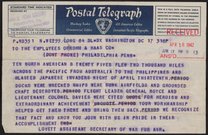Telegram from James H. Doolittle to the employees of Rohm & Haas, May 21, 1942
- 1942-May-21
James H. Doolittle (1896–1993) expressed his gratitude to the employees of Rohm and Haas for their contributions to the construction of bomber planes, which helped make a successful attack against Japanese forces possible.
In 1933, Röhm's experiments with the polymerization of methyl methacrylate led to the creation of a clear, solid plastic sheet, which he trademarked Plexiglas. During World War II, the demand for Plexiglas, which both Allied and Axis forces used for submarine periscopes and aircraft windshields, canopies, and gun turrets, helped transform Rohm and Haas into a major chemical firm.
A racist ethnic slur is used to refer to the Japanese is mentioned at the end of the letter. The use of this word reflects the heightened anti-Japanese sentiments that were fueled by World War II.
| Property | Value |
|---|---|
| Author | |
| Addressee | |
| Place of creation | |
| Format | |
| Genre | |
| Extent |
|
| Language | |
| Subject | |
| Rights | Public Domain Mark 1.0 |
| Credit line |
|
Institutional location
| Department | |
|---|---|
| Collection | |
| Physical container |
|
View collection guide View in library catalog
Related Items
Cite as
Doolittle, James Harold. “Telegram from James H. Doolittle to the Employees of Rohm & Haas, May 21, 1942,” May 21, 1942. Rohm & Haas Company Archives, Box 5, Folder 8. Science History Institute. Philadelphia. https://digital.sciencehistory.org/works/d9q5636.
This citation is automatically generated and may contain errors.






